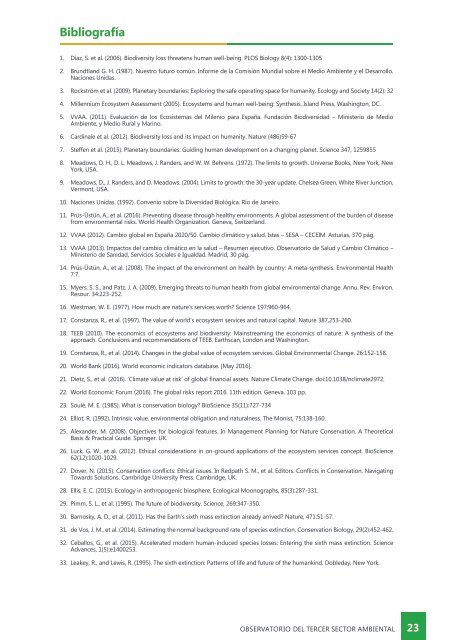IMPORTANCIA SOCIAL DEL MEDIO AMBIENTE Y LA BIODIVERSIDAD
2b0geXs
2b0geXs
Create successful ePaper yourself
Turn your PDF publications into a flip-book with our unique Google optimized e-Paper software.
Bibliografía<br />
1. Díaz, S. et al. (2006). Biodiversity loss threatens human well-being. PLOS Biology 8(4): 1300-1305<br />
2. Brundtland G. H. (1987). Nuestro futuro común. Informe de la Comisión Mundial sobre el Medio Ambiente y el Desarrollo.<br />
Naciones Unidas.<br />
3. Rockström et al. (2009). Planetary boundaries: Exploring the safe operating space for humanity. Ecology and Society 14(2): 32<br />
4. Millennium Ecosystem Assessment (2005). Ecosystems and human well-being: Synthesis. Island Press, Washington, DC.<br />
5. VVAA. (2011). Evaluación de los Ecosistemas del Milenio para España. Fundación Biodiversidad – Ministerio de Medio<br />
Ambiente, y Medio Rural y Marino.<br />
6. Cardinale et al. (2012). Biodiversity loss and its impact on humanity. Nature (486)59-67<br />
7. Steffen et al. (2015). Planetary boundaries: Guiding human development on a changing planet. Science 347, 1259855<br />
8. Meadows, D. H., D. L. Meadows, J. Randers, and W. W. Behrens. (1972). The limits to growth. Universe Books, New York, New<br />
York, USA.<br />
9. Meadows, D., J. Randers, and D. Meadows. (2004). Limits to growth: the 30-year update. Chelsea Green, White River Junction,<br />
Vermont, USA.<br />
10. Naciones Unidas. (1992). Convenio sobre la Diversidad Biológica. Río de Janeiro.<br />
11. Prüs-Üstün, A., et al. (2016). Preventing disease through healthy environments. A global assessment of the burden of disease<br />
from environmental risks. World Health Organization. Geneva, Switzerland.<br />
12. VVAA (2012). Cambio global en España 2020/50. Cambio climático y salud. Istas – SESA – CECEIM. Asturias, 370 pág.<br />
13. VVAA (2013). Impactos del cambio climático en la salud – Resumen ejecutivo. Observatorio de Salud y Cambio Climático –<br />
Ministerio de Sanidad, Servicios Sociales e Igualdad. Madrid, 30 pág.<br />
14. Prüs-Üstün, A., et al. (2008). The impact of the environment on health by country: A meta-synthesis. Environmental Health<br />
7:7.<br />
15. Myers, S. S., and Patz, J. A. (2009). Emerging threats to human health from global environmental change. Annu. Rev. Environ.<br />
Resour. 34:223-252.<br />
16. Westman, W. E. (1977). How much are nature’s services worth? Science 197:960-964.<br />
17. Constanza, R., et al. (1997). The value of world’s ecosystem services and natural capital. Nature 387,253-260.<br />
18. TEEB (2010). The economics of ecosystems and biodiversity: Mainstreaming the economics of nature: A synthesis of the<br />
approach. Conclusions and recommendations of TEEB. Earthscan, London and Washington.<br />
19. Constanza, R., et al. (2014). Changes in the global value of ecosystem services. Global Environmental Change. 26:152-158.<br />
20. World Bank (2016). World economic indicators database. [May 2016].<br />
21. Dietz, S., et al. (2016). ‘Climate value at risk’ of global financial assets. Nature Climate Change. doi:10.1038/nclimate2972.<br />
22. World Economic Forum (2016). The global risks report 2016. 11th edition. Geneva. 103 pp.<br />
23. Soulé, M. E. (1985). What is conservation biology? BioScience 35(11):727-734<br />
24. Elliot, R. (1992). Intrinsic value, environmental obligation and naturalness. The Monist, 75:138-160.<br />
25. Alexander, M. (2008). Objectives for biological features. In Management Planning for Nature Conservation. A Theoretical<br />
Basis & Practical Guide. Springer. UK.<br />
26. Luck, G. W., et al. (2012). Ethical considerations in on-ground applications of the ecosystem services concept. BioScience<br />
62(12):1020-1029.<br />
27. Dover, N. (2015). Conservation conflicts: Ethical issues. In Redpath S. M., et al. Editors. Conflicts in Conservation. Navigating<br />
Towards Solutions. Cambridge University Press. Cambridge, UK.<br />
28. Ellis, E. C. (2015). Ecology in anthropogenic biosphere. Ecological Moonographs, 85(3):287-331.<br />
29. Pimm, S. L., et al. (1995). The future of biodiversity. Science, 269:347-350.<br />
30. Barnosky, A. D., et al. (2011). Has the Earth’s sixth mass extinction already arrived? Nature, 471:51-57.<br />
31. de Vos, J. M., et al. (2014). Estimating the normal background rate of species extinction. Conservation Biology, 29(2):452-462.<br />
32. Ceballos, G., et al. (2015). Accelerated modern human-induced species losses: Entering the sixth mass extinction. Science<br />
Advances, 1(5):e1400253.<br />
33. Leakey, R., and Lewis, R. (1995). The sixth extinction: Patterns of life and future of the humankind. Dobleday, New York.<br />
OBSERVATORIO <strong>DEL</strong> TERCER SECTOR AMBIENTAL 23


